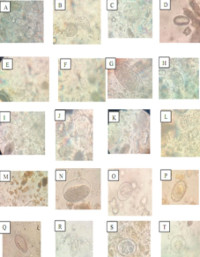Parasitic burden of African squirrels captured in a Nigerian University community https://doi.org/10.4314/njpar.v41i2.10
Main Article Content
Abstract
Most emerging diseases in humans have zoonotic reservoirs which are often wildlife species. In Nigeria, very few studies have reported parasites of small mammals with observed variations in parasitic burden. The parasitic burden of African squirrels captured in a University community was studied between November 2018 and February 2019.Atotal of 33 squirrels belonging to two species (Funisciurus anerythrus (60.6%) and Heliosciurus gambianus (39.4%)) were trapped with tomahawk live trap and examined for parasitic infections. The squirrels were examined for ectoparasites from skin scrapings. Blood and gastrointestinal content were collected to assess haemoparasites and gastrointestinal parasites, respectively. Haematological parameters were assessed. Six (18.2%) squirrels of 33 examined were positive for ectoparasite (mite) identified as Ornithonyssus bacoti. Haemoparasites identified include Trypanosoma spp. (9.1%), Plasmodium spp. (3.0%) and Microfilaria worm (3.0%), with overall prevalence of 15.2%. All the 33 squirrels captured were infected with helminth parasites. The small intestine and stomach had the highest and lowest parasitic ova counts, respectively. The parasite with the highest prevalence was Hymenolepis spp. (75.8%) and the lowest were Heligmosomoides spp. (3.0%), Oxyuroid ova (3.0%), Aspicularis spp. (3.0%), Strongyloides spp. (3.0%) and Schistosoma spp. (3.0%). Blood parameters according to species were not significant. However, animals with co-infection showed lower packed cell volume (PCV) and haemoglobin (Hb) values compared to single infections. Helminth-only infected squirrel showed marked eosinopenia. Parasites of public health importance were prevalent in squirrels trapped in the University community. Therefore, humans should avoid unprotected contact with squirrels and their excreta.
Article Details

This work is licensed under a Creative Commons Attribution-NonCommercial-NoDerivatives 4.0 International License.
References
Endris, M., Tekeste, Z., Lemma, W., Kassu, A. 2013. Comparison of the Kato-Katz, Wet Mount, and Formol-Ether concentration diagnostic
techniques for intestinal helminth infections in Ethiopia. ISRN Parasitology, Article ID 180439, 1-5. doi.org/10.5402/2013/180439
Chaisiri, K., Siribat, P., Ribas, A., Morand, S. (2015). Potentially zoonotic helminthiasis of murid rodents from the iNdo-Chinese peninsula:
impact of habitat and the risk of human infection. Vector borne and zoonotic diseases, 15(1): 73- 85.
Seebeck, J.H. 2015. Sciuridae. Fauna of Australia.Archived from the original (PDF).
Davidson, W.R. 1976. Endoparasites of selected populations of Gray squirrels (Sciurus carolinensis) in the southeastern United States.
Proceedings of the Helminthological Society, 43(2): 211-217
Bertolino, S., Lurz, P. 2013. Callosciurus squirrels: worldwide introductions, ecological impacts and recommendations to prevent the
establishment of new invasive populations. Mammal Review, 43: 22-333.
Odeniran, P.O., Ademola, I.O. 2016. Zoonotic parasites of wildlife in Africa: A review. African Journal of Wildlife Research, 46(1): 1-13
Ekong, P.S., Juryit, R., Dika, N.M., Nguku, P., Musenero, M. 2012. Prevalence and risk factors for zoonotic helminth infection among humans
and animals- Jos, Nigeria, 2005-2009. The Pan African Medical Journal, 12(1): 6.
Taylor, L.H., Latham, S.M., Woolhouse, M.E.J. 2001. Risk factors for human disease emergence. Philosophical Transaction of the Royal Society London, Ser.B- Biological Sciences, 356: 983- 989.
Odeniran, P.O., Ademola, I.O. and Jegede, H.O. 2018. A review of wildlife tourism and metaanalysis of parasitism in Africa's national parks and game reserves. Parasitology Research, 117(8): 2359-2378.
Pedersen, K., Anderson, T.D., Maison, R.M., Wiscomb, G.W., Pipas, M.J., Sinnett, D.R., Baroch, J.A., Gidlewski, T. 2018. Leptospira
antibodies detected in wildlife in the USAand the US Virgin Islands. Journal of Wildlife Diseases, 54(3): 450–459.
Singh, Y.P., Gangwar, S., Kumar, D. 1995. Rodent pests and their management in the northeastern hill region. Research Bulletin, 37:
Rafique, A., Rana, S.A., Khan, H.A., Sohail, A. 2009. Prevalence of some helminths in rodents captured from different city structures including poultry farms and human population of Faisalabad, Pakistan. Pakistan Veterinary Journal, 29(3): 141-144.
Vinay, K., Kriti, T., Shihnin, R., Chiranjay, M. 2014. Identification and preservation of intestinal parasites using methylene blueglycerol mount: a new approach to stool microscopy. Journal of Parasitology Research, Article ID672018, 4pages, http://dx.doi.org/10.1155/2014/672018
Jain, N.C. 1986. Schalm's Veterinary Haematology, 4th Ed. Lea and Febiger, Philadelphia, pp. 610-612.
Ademola I.O., Odeniran P.O. 2016. Co-infection with Plasmodium berghei and Trypanosoma brucei increase severity of malaria and
trypanosomiasis in mice. Acta Tropica, 159: 29- 35.
Tasawar, Z., Munir, U., Hayat, C.S., Lashari, M.H. 2007. Prevalence of Fasciola hepatica in goats around Multan. Pakistan Veterinary
Journal, 27(1): 5-7.
Taylor, M.A., Coop, R.L., Wall, R.L. 2007. Veterinary Parasitology. Blackwell Publishing, Oxford, UK.
Odeniran P.O., Macleod, E.T., Ademola, I.O., Welburn, S.C. 2019. Molecular identification of bloodmeal source and trypanosomes in Glossina spp. Tabanus spp. and Stomoxys spp. trapped from cattle from settlements in southwest Nigeria. Medical and Veterinary Entomology, 33(2): 269-281.
Kelaher, J., Jogi, R., Katta, R. 2005. An outbreak of rat mite dermatitis in an animal research facility. Cutis, 75(5): 282–286.
Ayinmode, A.B., Ndudim, N.F., Obebe, O.O. 2018. Prevalence of gastrointestinal parasites of rodents in Ibadan, Nigeria. Nigerian Veterinary Journal, 36(2): 1158-1164.
Ceruti, R., Sonzogni, O., Origgi, F., Vezzoli, F., Cammarata, S., Giusti, A.M., Scanziani, E. 2001. Capillaria hepatica infection in wild brown rats
(Rattus norvegicus) from the urban area of Milan, Italy. Journal of Veterinary Medicine Series B, 48: 235–240.
Baker, D.G. 2007. Flynn’s parasites of laboratory animals, 2nd ed. Blackwell,Ames, IA, 813 pp
Mathison, B.A., Pritt, B.S. 2018. A systematic overview of zoonotic helminth infections in North America. Laboratory Medicine, 49(4):
e61-93.
Muller, R. 1975. Worm and Disease, a Manual of Medical Helminthology.1st ed. London, UK: William Heinemann Medical Book Ltd; 1975.p.
Beaver, P.C., Jung, R.C., Cupp, E.W. 1984. Clinical Parasitology. 9th ed. Philadelphia, USA: Lea and Febiger; pp. 544–547.
Ikeh, E.I., Anosike, J.C., Okon, E. 1992. Acanthocephalan infection in man in northern Nigeria. Journal of Helminthology, 66: 241–242
Hart, B.L., Hart, L.A. 2018. How mammals stay healthy in nature: the evolution of behaviours to avoid parasites and pathogens. Philosophy Transactions of the Royal Society B, 373: 20170205


